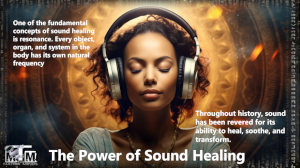The Power of Sound Healing: An Ancient Practice for Modern Wellness

Throughout history, sound has been revered for its ability to heal, soothe, and transform. From the rhythmic beating of drums in indigenous rituals to the melodic chants of Tibetan monks, cultures around the world have recognized the profound impact of sound on the human mind, body, and spirit. In recent years, the ancient practice of sound healing has experienced a resurgence as people seek natural and holistic approaches to wellness. We explore the principles and benefits of sound healing and how it can be integrated into modern lifestyles.
Understanding Sound Healing
At its core, sound healing is based on the principle that everything in the universe, including our bodies, is in a constant state of vibration. When these vibrations become imbalanced or disrupted, it can lead to physical, emotional, and spiritual disharmony. Sound healing seeks to restore balance by using specific frequencies, rhythms, and vibrations to entrain the body’s natural healing mechanisms.
One of the fundamental concepts of sound healing is resonance. Every object, organ, and system in the body has its own natural frequency. When exposed to external vibrations that match these frequencies, resonance occurs, amplifying the body’s innate healing processes. This phenomenon is akin to the sympathetic vibration that causes a tuning fork to resonate when struck by a sound of the same frequency.
Tools and Techniques
Sound healing employs a variety of tools and techniques to facilitate healing and relaxation. Some of the most common instruments used include:
- Tuning Forks: Tuning forks are metal instruments that produce a pure tone when struck. They are often used to stimulate acupressure points, chakras, and energy meridians, promoting balance and vitality.
- Crystal Singing Bowls: Crystal singing bowls are made from quartz crystal and produce a rich, harmonic sound when struck or played with a mallet. Each bowl is tuned to a specific frequency, corresponding to different chakras or energy centers in the body.
- Drums and Percussion: Rhythmic drumming and percussion have been used for millennia in shamanic and ceremonial practices to induce trance states, release tension, and facilitate healing.
- Voice and Mantras: Chanting, singing, and vocal toning are powerful tools for sound healing. The human voice can create a wide range of frequencies and vibrations that resonate with different parts of the body and psyche.
- Gongs and Singing Bells: Gongs and singing bells produce deep, penetrating tones that can induce profound states of relaxation and meditation. Their complex harmonics can help release energetic blockages and promote flow within the body’s subtle energy systems.
Benefits of Sound Healing
The benefits of sound healing are wide-ranging and can encompass physical, emotional, mental, and spiritual well-being. Some of the potential benefits include:
- Stress Reduction: Sound healing has been shown to reduce stress levels, lower blood pressure, and promote relaxation by calming the nervous system and inducing a meditative state.
- Pain Relief: Certain frequencies and vibrations have analgesic properties and can help alleviate chronic pain, tension, and discomfort in the body.
- Emotional Release: Sound healing can facilitate the release of stored emotions, trauma, and negative thought patterns, allowing for greater emotional resilience and self-awareness.
- Enhanced Creativity and Intuition: By balancing the brain hemispheres and stimulating the pineal gland, sound healing can enhance creativity, intuition, and spiritual awareness.
- Improved Sleep: Sound healing can promote deep relaxation and improve sleep quality by entraining the brainwaves into the delta and theta states associated with restorative sleep.
Integrating Sound Healing into Daily Life
Sound healing practices can be integrated into daily life in various ways to support overall health and well-being. Here are some suggestions:
- Listening to Healing Music: Incorporate soothing music or soundscapes into your daily routine for relaxation, meditation, or mindfulness practices.
- Self-Toning and Vocalization: Experiment with vocal toning, humming, or chanting to release tension, balance your energy, and uplift your mood.
- Sound Baths and Meditation: Attend sound healing sessions, workshops, or retreats to experience the transformative power of live sound immersion.
- Creating Sacred Space: Use sound to create a sacred space in your home or workplace by playing singing bowls, bells, or other healing instruments.
- Group Ceremonies and Circles: Participate in group sound ceremonies, drum circles, or chanting circles to cultivate community, connection, and collective healing.
Sound healing is a profound and ancient practice that offers a holistic approach to wellness and transformation. By harnessing the power of sound and vibration, we can harmonize our bodies, minds, and spirits, leading to greater health, happiness, and wholeness. Whether through the gentle tones of a singing bowl or the rhythmic pulse of a drum, sound has the potential to uplift, heal, and inspire us on our journey of self-discovery and awakening.
Binaural Beats
Binaural beats are a fascinating auditory phenomenon that has gained attention in recent years for its potential healing and therapeutic effects. This phenomenon occurs when two slightly different frequencies are presented separately to each ear, creating an illusion of a third frequency. The brain perceives this third frequency, known as the binaural beat, as a rhythmic pulsation.
For example, if a 300 Hz tone is presented to one ear and a 310 Hz tone is presented to the other ear, the brain will perceive a binaural beat with a frequency of 10 Hz (310 Hz – 300 Hz). This perceived beat corresponds to the difference between the two tones and is not actually present in the auditory stimulus.
The healing ability of binaural beats is often attributed to their ability to entrain brainwave activity. Brainwaves are rhythmic patterns of neural activity that correspond to different states of consciousness, such as relaxation, meditation, or focus. Binaural beats are believed to influence brainwave activity by synchronizing the brainwaves to the frequency of the binaural beat.
Here’s how it works:
- Delta (0.5-4 Hz): Associated with deep sleep and relaxation. Binaural beats in the delta range are believed to promote restorative sleep, reduce insomnia, and induce deep relaxation.
- Theta (4-8 Hz): Associated with meditation, creativity, and deep relaxation. Binaural beats in the theta range are believed to enhance meditation practices, reduce stress, and promote emotional healing.
- Alpha (8-12 Hz): Associated with relaxed alertness and calmness. Binaural beats in the alpha range are believed to promote relaxation, reduce anxiety, and improve focus and concentration.
- Beta (12-30 Hz): Associated with active alertness and cognitive function. Binaural beats in the beta range are believed to enhance cognitive performance, increase mental clarity, and improve memory and focus.
- Gamma (30-100 Hz): Associated with heightened perception and consciousness. Binaural beats in the gamma range are believed to enhance sensory perception, promote spiritual awareness, and facilitate peak performance states.
The healing ability of binaural beats is still being researched, and their effectiveness can vary depending on individual factors such as frequency sensitivity, state of consciousness, and overall health. However, many people report positive experiences with binaural beats for relaxation, stress reduction, meditation, and cognitive enhancement.

It’s important to note that binaural beats are not a cure-all solution and should not replace professional medical treatment for serious health conditions. However, they can be a valuable tool for enhancing overall well-being and supporting holistic health practices. If you’re interested in exploring binaural beats for healing purposes, consider incorporating them into your meditation, relaxation, or mindfulness practices and observe how they affect your mood, focus, and overall state of being.



Leave a Reply
Want to join the discussion?Feel free to contribute!